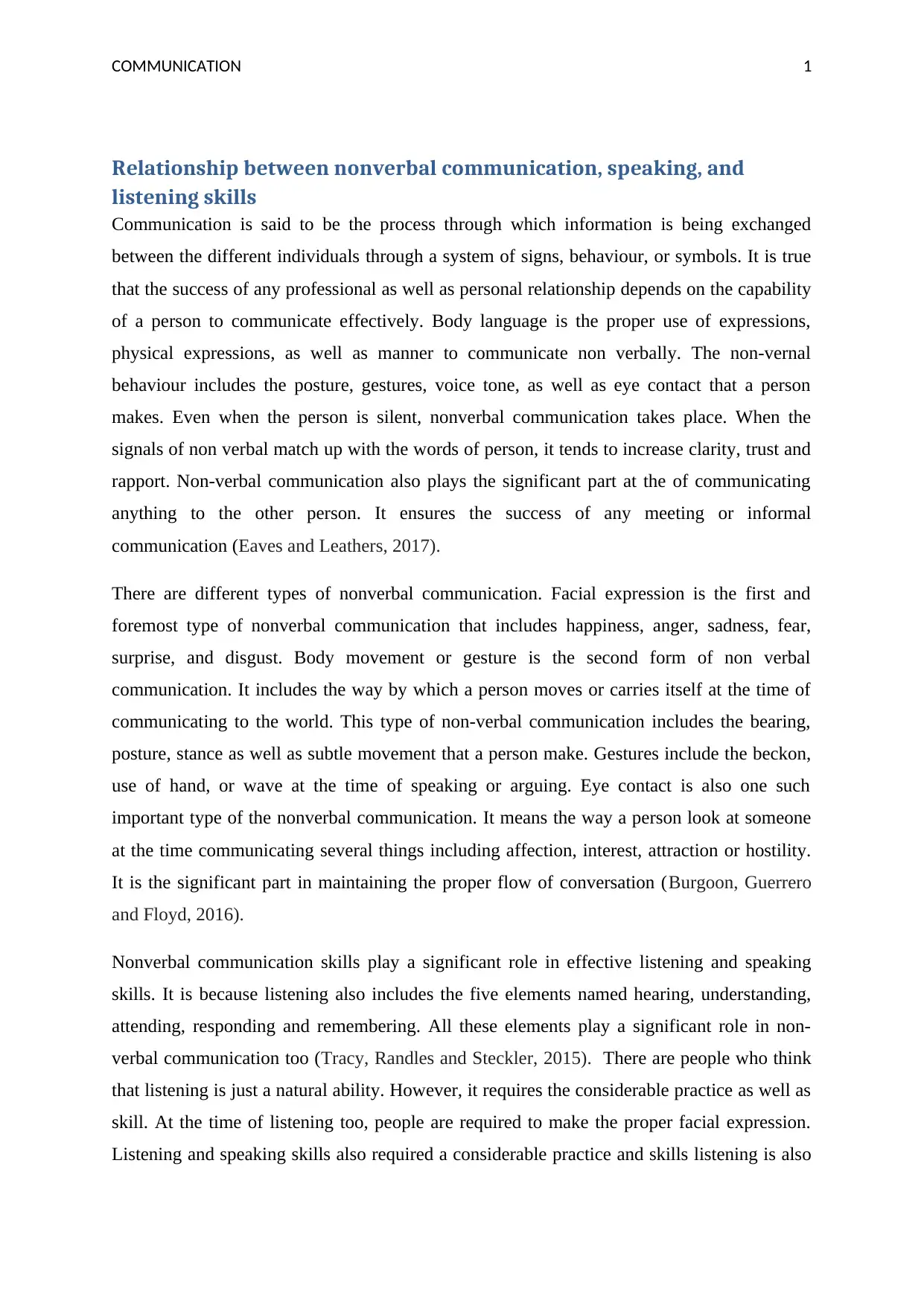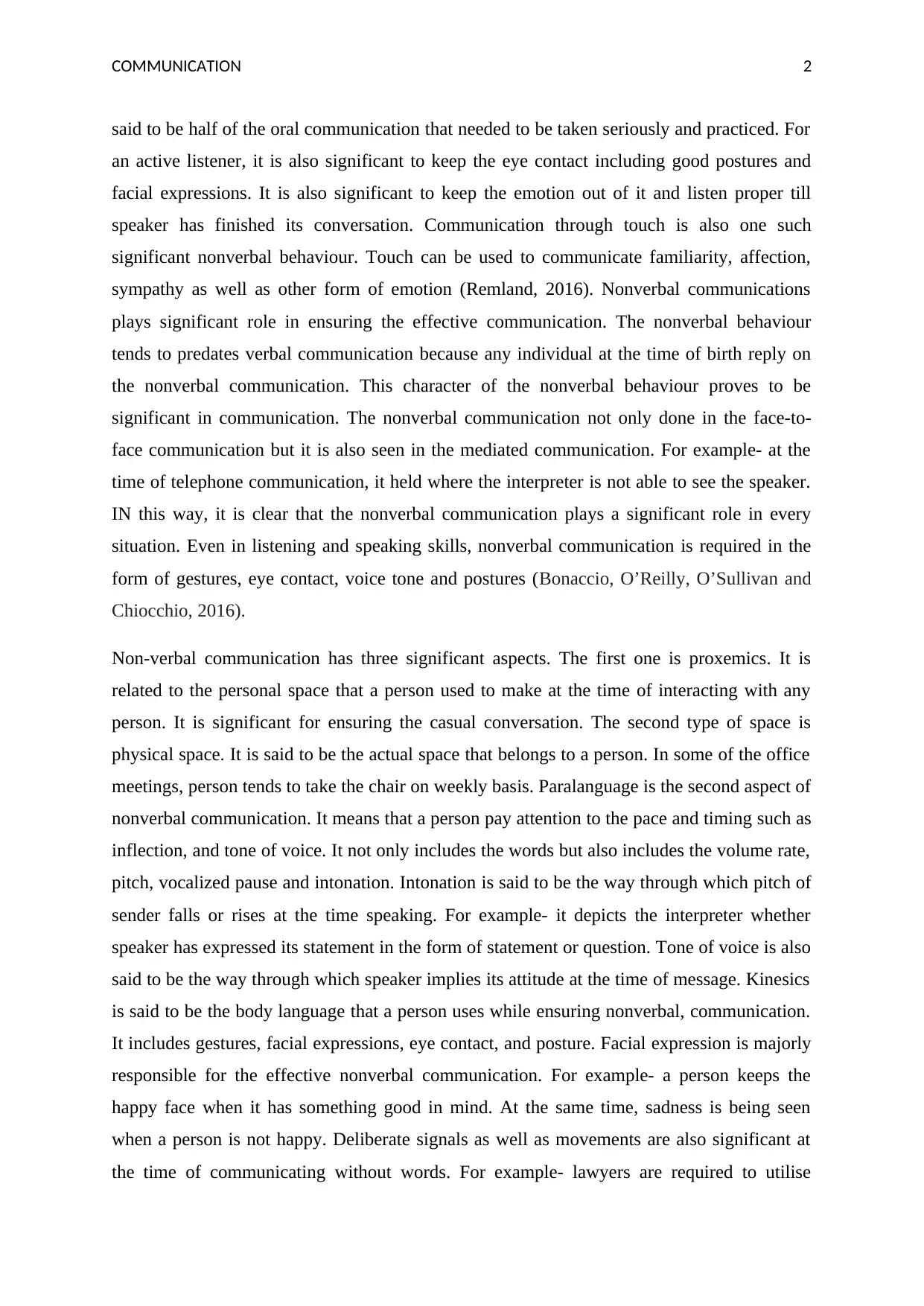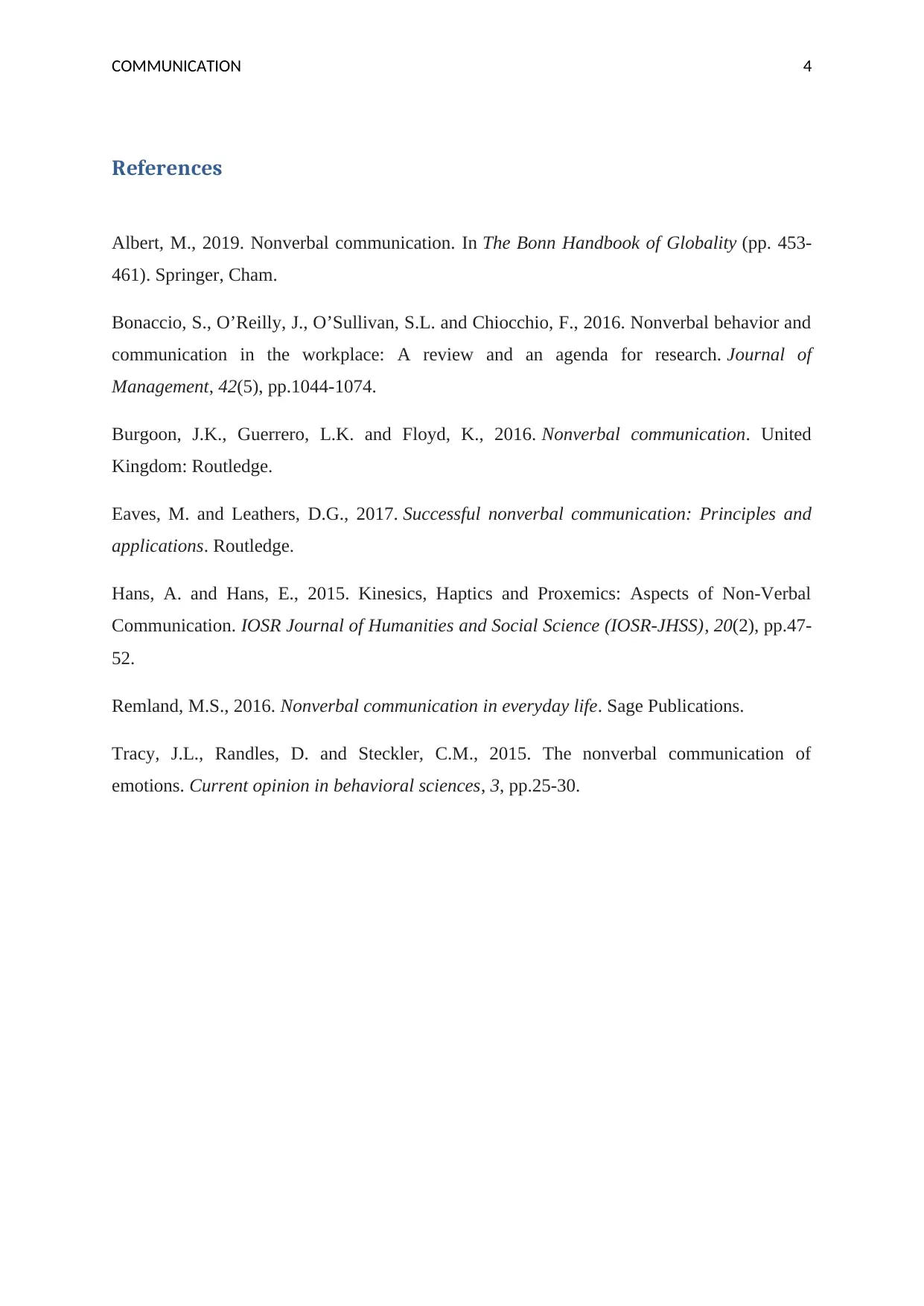BBUS1003 Business Communication: Nonverbal Communication Case Study
VerifiedAdded on 2022/11/01
|5
|1239
|206
Case Study
AI Summary
This case study report delves into the crucial role of nonverbal communication in business settings, analyzing its impact on both speaking and listening skills. The report begins by defining communication and highlighting the significance of effective communication in professional and personal relationships. It then explores various types of nonverbal communication, including facial expressions, body movements, gestures, and eye contact, providing detailed examples of each. The core of the report examines how nonverbal cues enhance listening and speaking skills, emphasizing the importance of elements such as facial expressions, eye contact, and posture. Furthermore, the report discusses the three significant aspects of nonverbal communication: proxemics, paralanguage, and kinesics, illustrating how these factors influence interactions. The analysis incorporates relevant research, referencing sources to support the arguments presented. Ultimately, the case study underscores the importance of understanding and utilizing nonverbal communication for improved clarity, trust, and rapport in all forms of communication.

Running Head: COMMUNICATION 0
Business Communication
Business Communication
Paraphrase This Document
Need a fresh take? Get an instant paraphrase of this document with our AI Paraphraser

COMMUNICATION 1
Relationship between nonverbal communication, speaking, and
listening skills
Communication is said to be the process through which information is being exchanged
between the different individuals through a system of signs, behaviour, or symbols. It is true
that the success of any professional as well as personal relationship depends on the capability
of a person to communicate effectively. Body language is the proper use of expressions,
physical expressions, as well as manner to communicate non verbally. The non-vernal
behaviour includes the posture, gestures, voice tone, as well as eye contact that a person
makes. Even when the person is silent, nonverbal communication takes place. When the
signals of non verbal match up with the words of person, it tends to increase clarity, trust and
rapport. Non-verbal communication also plays the significant part at the of communicating
anything to the other person. It ensures the success of any meeting or informal
communication (Eaves and Leathers, 2017).
There are different types of nonverbal communication. Facial expression is the first and
foremost type of nonverbal communication that includes happiness, anger, sadness, fear,
surprise, and disgust. Body movement or gesture is the second form of non verbal
communication. It includes the way by which a person moves or carries itself at the time of
communicating to the world. This type of non-verbal communication includes the bearing,
posture, stance as well as subtle movement that a person make. Gestures include the beckon,
use of hand, or wave at the time of speaking or arguing. Eye contact is also one such
important type of the nonverbal communication. It means the way a person look at someone
at the time communicating several things including affection, interest, attraction or hostility.
It is the significant part in maintaining the proper flow of conversation (Burgoon, Guerrero
and Floyd, 2016).
Nonverbal communication skills play a significant role in effective listening and speaking
skills. It is because listening also includes the five elements named hearing, understanding,
attending, responding and remembering. All these elements play a significant role in non-
verbal communication too (Tracy, Randles and Steckler, 2015). There are people who think
that listening is just a natural ability. However, it requires the considerable practice as well as
skill. At the time of listening too, people are required to make the proper facial expression.
Listening and speaking skills also required a considerable practice and skills listening is also
Relationship between nonverbal communication, speaking, and
listening skills
Communication is said to be the process through which information is being exchanged
between the different individuals through a system of signs, behaviour, or symbols. It is true
that the success of any professional as well as personal relationship depends on the capability
of a person to communicate effectively. Body language is the proper use of expressions,
physical expressions, as well as manner to communicate non verbally. The non-vernal
behaviour includes the posture, gestures, voice tone, as well as eye contact that a person
makes. Even when the person is silent, nonverbal communication takes place. When the
signals of non verbal match up with the words of person, it tends to increase clarity, trust and
rapport. Non-verbal communication also plays the significant part at the of communicating
anything to the other person. It ensures the success of any meeting or informal
communication (Eaves and Leathers, 2017).
There are different types of nonverbal communication. Facial expression is the first and
foremost type of nonverbal communication that includes happiness, anger, sadness, fear,
surprise, and disgust. Body movement or gesture is the second form of non verbal
communication. It includes the way by which a person moves or carries itself at the time of
communicating to the world. This type of non-verbal communication includes the bearing,
posture, stance as well as subtle movement that a person make. Gestures include the beckon,
use of hand, or wave at the time of speaking or arguing. Eye contact is also one such
important type of the nonverbal communication. It means the way a person look at someone
at the time communicating several things including affection, interest, attraction or hostility.
It is the significant part in maintaining the proper flow of conversation (Burgoon, Guerrero
and Floyd, 2016).
Nonverbal communication skills play a significant role in effective listening and speaking
skills. It is because listening also includes the five elements named hearing, understanding,
attending, responding and remembering. All these elements play a significant role in non-
verbal communication too (Tracy, Randles and Steckler, 2015). There are people who think
that listening is just a natural ability. However, it requires the considerable practice as well as
skill. At the time of listening too, people are required to make the proper facial expression.
Listening and speaking skills also required a considerable practice and skills listening is also

COMMUNICATION 2
said to be half of the oral communication that needed to be taken seriously and practiced. For
an active listener, it is also significant to keep the eye contact including good postures and
facial expressions. It is also significant to keep the emotion out of it and listen proper till
speaker has finished its conversation. Communication through touch is also one such
significant nonverbal behaviour. Touch can be used to communicate familiarity, affection,
sympathy as well as other form of emotion (Remland, 2016). Nonverbal communications
plays significant role in ensuring the effective communication. The nonverbal behaviour
tends to predates verbal communication because any individual at the time of birth reply on
the nonverbal communication. This character of the nonverbal behaviour proves to be
significant in communication. The nonverbal communication not only done in the face-to-
face communication but it is also seen in the mediated communication. For example- at the
time of telephone communication, it held where the interpreter is not able to see the speaker.
IN this way, it is clear that the nonverbal communication plays a significant role in every
situation. Even in listening and speaking skills, nonverbal communication is required in the
form of gestures, eye contact, voice tone and postures (Bonaccio, O’Reilly, O’Sullivan and
Chiocchio, 2016).
Non-verbal communication has three significant aspects. The first one is proxemics. It is
related to the personal space that a person used to make at the time of interacting with any
person. It is significant for ensuring the casual conversation. The second type of space is
physical space. It is said to be the actual space that belongs to a person. In some of the office
meetings, person tends to take the chair on weekly basis. Paralanguage is the second aspect of
nonverbal communication. It means that a person pay attention to the pace and timing such as
inflection, and tone of voice. It not only includes the words but also includes the volume rate,
pitch, vocalized pause and intonation. Intonation is said to be the way through which pitch of
sender falls or rises at the time speaking. For example- it depicts the interpreter whether
speaker has expressed its statement in the form of statement or question. Tone of voice is also
said to be the way through which speaker implies its attitude at the time of message. Kinesics
is said to be the body language that a person uses while ensuring nonverbal, communication.
It includes gestures, facial expressions, eye contact, and posture. Facial expression is majorly
responsible for the effective nonverbal communication. For example- a person keeps the
happy face when it has something good in mind. At the same time, sadness is being seen
when a person is not happy. Deliberate signals as well as movements are also significant at
the time of communicating without words. For example- lawyers are required to utilise
said to be half of the oral communication that needed to be taken seriously and practiced. For
an active listener, it is also significant to keep the eye contact including good postures and
facial expressions. It is also significant to keep the emotion out of it and listen proper till
speaker has finished its conversation. Communication through touch is also one such
significant nonverbal behaviour. Touch can be used to communicate familiarity, affection,
sympathy as well as other form of emotion (Remland, 2016). Nonverbal communications
plays significant role in ensuring the effective communication. The nonverbal behaviour
tends to predates verbal communication because any individual at the time of birth reply on
the nonverbal communication. This character of the nonverbal behaviour proves to be
significant in communication. The nonverbal communication not only done in the face-to-
face communication but it is also seen in the mediated communication. For example- at the
time of telephone communication, it held where the interpreter is not able to see the speaker.
IN this way, it is clear that the nonverbal communication plays a significant role in every
situation. Even in listening and speaking skills, nonverbal communication is required in the
form of gestures, eye contact, voice tone and postures (Bonaccio, O’Reilly, O’Sullivan and
Chiocchio, 2016).
Non-verbal communication has three significant aspects. The first one is proxemics. It is
related to the personal space that a person used to make at the time of interacting with any
person. It is significant for ensuring the casual conversation. The second type of space is
physical space. It is said to be the actual space that belongs to a person. In some of the office
meetings, person tends to take the chair on weekly basis. Paralanguage is the second aspect of
nonverbal communication. It means that a person pay attention to the pace and timing such as
inflection, and tone of voice. It not only includes the words but also includes the volume rate,
pitch, vocalized pause and intonation. Intonation is said to be the way through which pitch of
sender falls or rises at the time speaking. For example- it depicts the interpreter whether
speaker has expressed its statement in the form of statement or question. Tone of voice is also
said to be the way through which speaker implies its attitude at the time of message. Kinesics
is said to be the body language that a person uses while ensuring nonverbal, communication.
It includes gestures, facial expressions, eye contact, and posture. Facial expression is majorly
responsible for the effective nonverbal communication. For example- a person keeps the
happy face when it has something good in mind. At the same time, sadness is being seen
when a person is not happy. Deliberate signals as well as movements are also significant at
the time of communicating without words. For example- lawyers are required to utilise
⊘ This is a preview!⊘
Do you want full access?
Subscribe today to unlock all pages.

Trusted by 1+ million students worldwide

COMMUNICATION 3
several nonverbal signals in the setting of courtroom. These signals are said to be more
powerful that some of the judges place limits on these kind of nonverbal behaviour (Albert,
2019).
several nonverbal signals in the setting of courtroom. These signals are said to be more
powerful that some of the judges place limits on these kind of nonverbal behaviour (Albert,
2019).
Paraphrase This Document
Need a fresh take? Get an instant paraphrase of this document with our AI Paraphraser

COMMUNICATION 4
References
Albert, M., 2019. Nonverbal communication. In The Bonn Handbook of Globality (pp. 453-
461). Springer, Cham.
Bonaccio, S., O’Reilly, J., O’Sullivan, S.L. and Chiocchio, F., 2016. Nonverbal behavior and
communication in the workplace: A review and an agenda for research. Journal of
Management, 42(5), pp.1044-1074.
Burgoon, J.K., Guerrero, L.K. and Floyd, K., 2016. Nonverbal communication. United
Kingdom: Routledge.
Eaves, M. and Leathers, D.G., 2017. Successful nonverbal communication: Principles and
applications. Routledge.
Hans, A. and Hans, E., 2015. Kinesics, Haptics and Proxemics: Aspects of Non-Verbal
Communication. IOSR Journal of Humanities and Social Science (IOSR-JHSS), 20(2), pp.47-
52.
Remland, M.S., 2016. Nonverbal communication in everyday life. Sage Publications.
Tracy, J.L., Randles, D. and Steckler, C.M., 2015. The nonverbal communication of
emotions. Current opinion in behavioral sciences, 3, pp.25-30.
References
Albert, M., 2019. Nonverbal communication. In The Bonn Handbook of Globality (pp. 453-
461). Springer, Cham.
Bonaccio, S., O’Reilly, J., O’Sullivan, S.L. and Chiocchio, F., 2016. Nonverbal behavior and
communication in the workplace: A review and an agenda for research. Journal of
Management, 42(5), pp.1044-1074.
Burgoon, J.K., Guerrero, L.K. and Floyd, K., 2016. Nonverbal communication. United
Kingdom: Routledge.
Eaves, M. and Leathers, D.G., 2017. Successful nonverbal communication: Principles and
applications. Routledge.
Hans, A. and Hans, E., 2015. Kinesics, Haptics and Proxemics: Aspects of Non-Verbal
Communication. IOSR Journal of Humanities and Social Science (IOSR-JHSS), 20(2), pp.47-
52.
Remland, M.S., 2016. Nonverbal communication in everyday life. Sage Publications.
Tracy, J.L., Randles, D. and Steckler, C.M., 2015. The nonverbal communication of
emotions. Current opinion in behavioral sciences, 3, pp.25-30.
1 out of 5
Related Documents
Your All-in-One AI-Powered Toolkit for Academic Success.
+13062052269
info@desklib.com
Available 24*7 on WhatsApp / Email
![[object Object]](/_next/static/media/star-bottom.7253800d.svg)
Unlock your academic potential
Copyright © 2020–2025 A2Z Services. All Rights Reserved. Developed and managed by ZUCOL.




